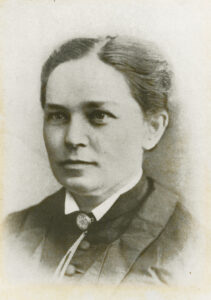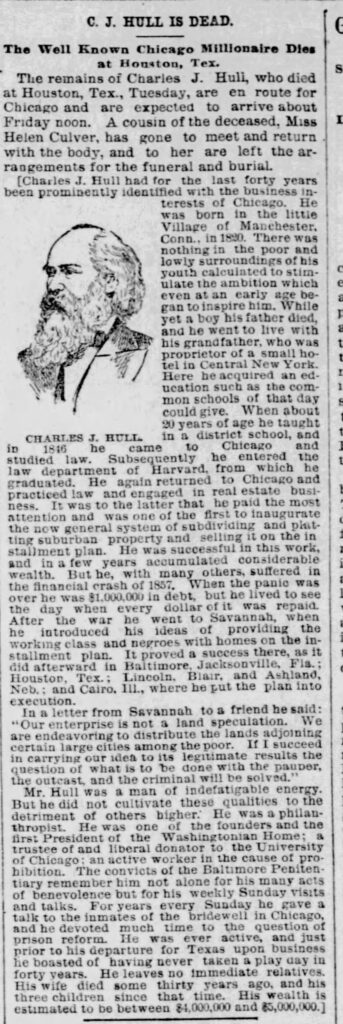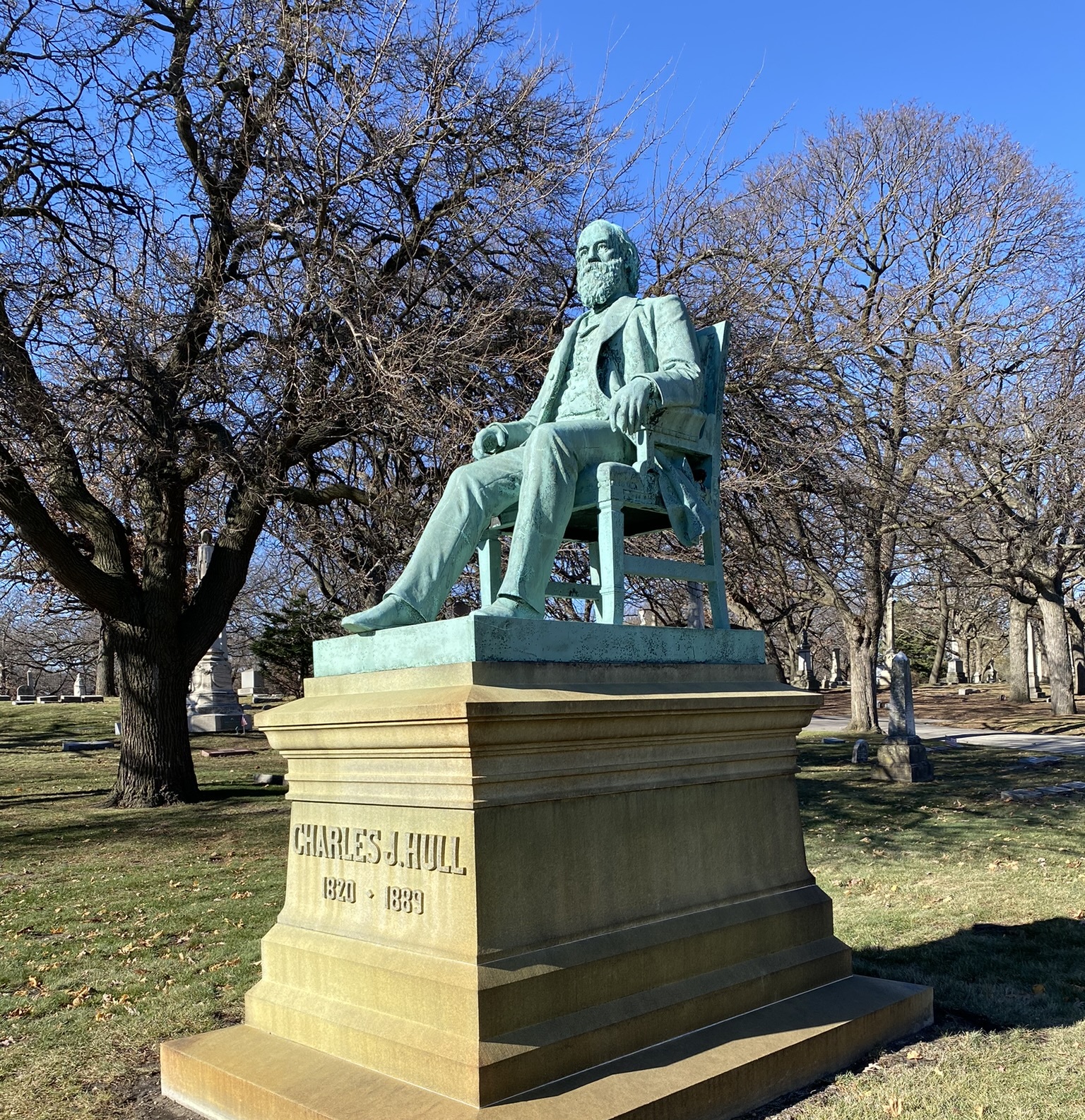Charles Jerold Hull
18 March 1820 – 12 February 1889
Helen Culver
23 Mar 1832 – 19 Aug 1925
Charles Jerold Hull was what could be termed a self-made millionaire, making his fortune in real-estate in both Chicago and across the US. According to the Tribune in his 14th of February 1889 obituary, his father died when he was young, and he went to live with his grandfather who owned a small hotel. It was there he learned business, and though he started out as a teacher but in 1846, he moved to Chicago to study law, eventually graduating from Harvard Law upon which he returned again to Chicago to practice law and make a start in real estate.
Real estate is where he built his business and his fortune. He was an eccentric character and reform-minded in that he saw land development less as a money-making proposition (though it was definitely that) than as a way to house the unhoused and improve the lives of what he likely thought of as the ambitious poor. He sold land to anyone who wanted it and for those who couldn’t afford to buy it outright, he allowed for small payments to be made over many years. As this sounds like the modern mortgage, one wonders how that all worked back in the mid-1800s and what the interest rate might have been.
Another eccentric method of his involved seeding neighborhoods in the Chicago area by building himself a grand (though not palatial) home in an undeveloped area to encourage further development and then moving to a new undeveloped area to start the process over again once his method had been successful.
As is not unusual for people who “made their own fortune,” he was fairly judgmental of those who failed (in his opinion) to take advantage of opportunities to improve themselves but he was also — as outlined above — willing to offer opportunities to those that many other wealthy men of the era did not. He was anti-charity though supportive of higher education and vocational training. He was a prison reformer only in that he thought prisons should provide vocational training and other reform-oriented opportunities — not that there should be fewer prisons or equal justice initiatives.
Charles married Melicent A C Loomis in the 1840s, and together they had (at least) three children. Sadly, their youngest child Louis died in infancy, Melicent died in 1860, and their two older children both died in young adulthood.

After Melicent’s death, Charles’s first cousin Helen Culver came to live with him and help take care of his surviving children.
Helen’s childhood was full of both unusual opportunity and hard tragedy. Her father was a well-off farmer who made his money by buying, clearing, and reselling land, but this work meant the family lived out in the wilderness for most of her childhood. When she was just six years old, she lost her mother and she and her siblings went to live with their aunts for a time. Her father eventually remarried and had two more children. Helen was an avid reader from a young age and was able to pursue higher education even at a time such a thing was quite rare for a woman to do, but when she was 20 years old and finishing university, her father died suddenly of Typhoid fever, and she found herself effectively left penniless as his estate was left entirely to her stepmother and half-siblings. Fortunately, Helen was able to graduate, and she and her brother Robert went west to Illinois to live near their grandfather and establish themselves. Helen spent the next several years teaching, moving to Chicago to continue this vocation in 1854.
She left teaching in 1860 when she went to live with Charles and his children and that might seem to be a very traditional choice for a mid-1800s spinster, but Helen had lived a wildly independent life both up to this point and afterwards. Within just a few years of coming to stay with the Hulls, Helen volunteered and served as a Union nurse in the Civil War, at one point being in charge of a 40-bed hospital, so her ability to manage high-stakes high-pressure literal life-and-death situations was well-established. It’s unclear when she first volunteered (her obituary says it was 1863 but other accounts imply an earlier date), but as she served under the United States Sanitary Commission which was established mid-1861 and ran the hospital mentioned above in early 1863, it was somewhere in there. She returned to Chicago and the Hull family after the war, where sadly Charles’s son Charles Morley died at just 19 of cholera in 1866. His father was advised to give him brandy but was such a strident teetotaler that he refused, declaring it was better that his son die than live “…with a thirst for rum.” Which: yikes.
In 1868, Helen went to work with Charles in his real-estate business. Charles’s daughter Fredrika died at just 24 years old in 1874, but Helen and Charles continued to work together until his death fifteen years later.

Charles suffered from kidney disease (then called Bright’s Disease) and while spending several months in Texas (it’s unclear if this was for business or health purposes), he passed away in 1889 at just a month shy of his 69th birthday. Upon his death, Helen traveled to Houston herself to bring his body back to Chicago for interment at Rose Hill. It’s unclear who commissioned the statue of Charles that adorns the family plot, but I suspect it was Helen.
According to later news reports, Charles was generous with his siblings’ children largely in the form of providing work and education opportunities to them (as was his way of “improving” anyone, it seems). This led to a very dramatic will-reading in the days following his death when his nieces and nephews discovered that Charles’s entire estate had been left to Helen — I suspect because of them all, she had risen to the opportunities offered better than any of them (one newspaper account implies several instances of the younger relatives quitting or failing to meet expectations in their own Charles-provided opportunities).
The will was disputed but ultimately Helen was left as the sole inheritor, though it appears she agreed to a settlement to the contesting heirs (and on her part a stipulation that minor heirs be included in this settlement) in exchange for their dropping all opposition to the will. Charles’s estate was valued at about $4 million dollars upon his death which would be about $133.5 million dollars today.
Despite the opposition, Helen remained in charge of the business, properties, and wealth for the rest of her life. Her attitude toward charity seems to have been somewhat more open-minded and wider-ranging though her interests were similar to Charles’s — education and providing opportunities among them.
One of the most important charitable investments Helen made was to — almost immediately upon her inheritance — grant social reformer Jane Addams a 25-year rent-free lease to Hull House which became the original location of her settlement house organization. Helen also acted as a trustee of the organization until 1897. Hull House had been one of Charles’s neighborhood seed homes, and still stands as a museum on the University of Illinois Chicago (UIC) campus. Sadly, the Hull House settlement complex which had grown around that first founding building once owned by Charles and Helen fell victim to the vast urban “renewal” push in the late 50s/early 60s that saw decades-old neighborhoods bulldozed for so-called improvements such as the creation of the UIC campus and the construction of interstates that destroyed vibrant, diverse communities and displaced thousands in Chicago and millions nationwide.
Helen also donated more than $1 million to the University of Chicago during her lifetime (which depending on exactly when that donation took place would be worth about $30 million or more in today’s money) as well as an additional $600K in her will ($10.5 million today). She was also an early and strong supporter of women’s suffrage and was an extremely generous philanthropist supporting many other organizations and causes.
It says something of the impact of her work and philanthropy that she has a Wikipedia entry and Charles does not. He has the statue, but she earned a legacy. Helen died at the home of her nephew in Lake Forest at the age of 93. Unlike her cousin (whose aim in choosing a single heir seems to have been to protect his legacy), upon her death, Helen’s will dissolved the estate entirely, leaving generous bequests to many charitable and educational institutions, relatives, and employees.
RIP Charles and Helen
Please visit my Instagram for any questions or comments on this post!
Additional Resources
- Inter Ocean, 21 February 1889, page 3, “A Millionaire’s Money”
- Chicago Tribune, 21 February 1889, p1, “Miss Culver’s Fortune”
- Chicago Tribune, 22 February 1889, p1, “Hull’s Characteristics”
- Building for a Long Future: The University of Chicago and Its Donors, 1889 – 1930: Helen Culver (via the Wayback Machine)
- Helen Culver — Wikipedia
- Hull House — Wikipedia
- Jane Addams Hull-House Museum (hullhousemuseum.org)
- Lake Forest Country Places: Rookwoods
- Helen Culver (1832-1925) — Find a Grave Memorial
- Charles Jerold Hull (1820-1889) — Find a Grave Memorial
